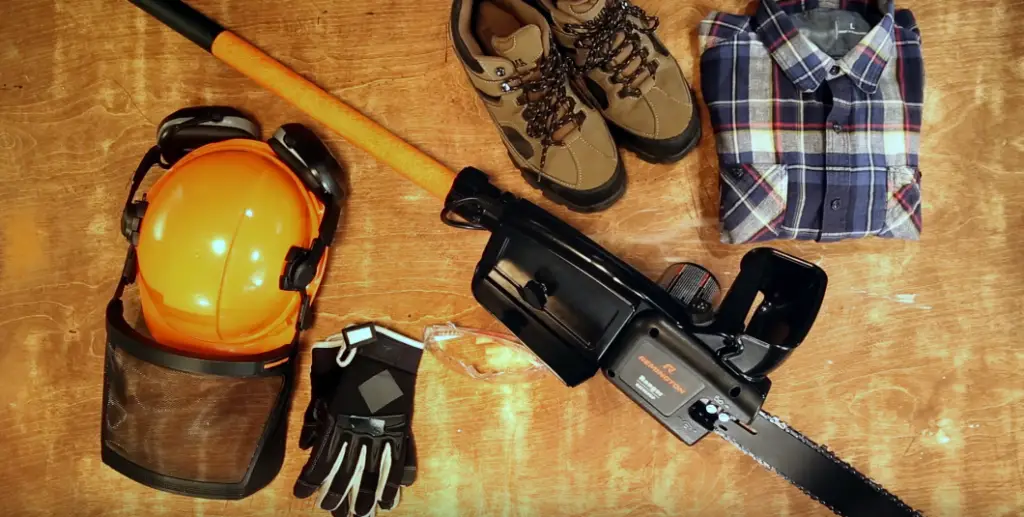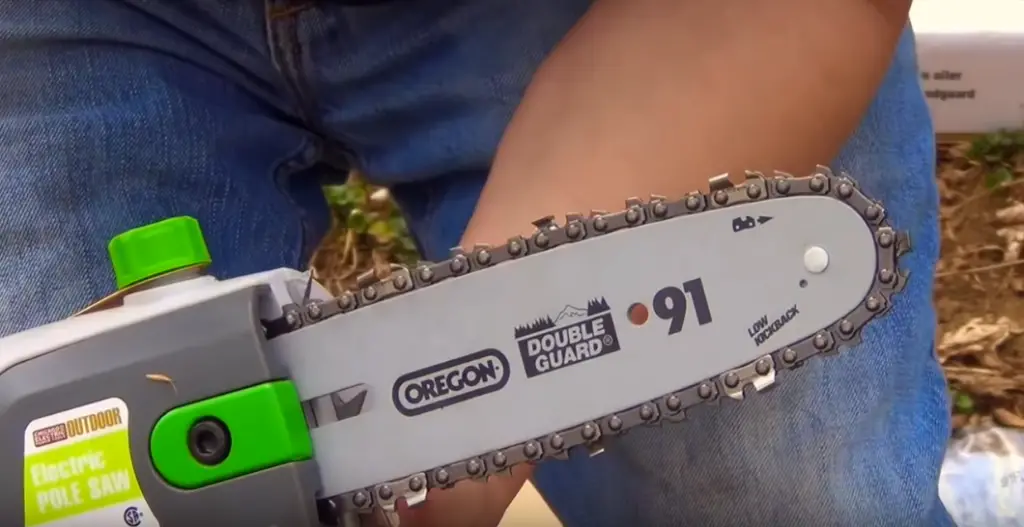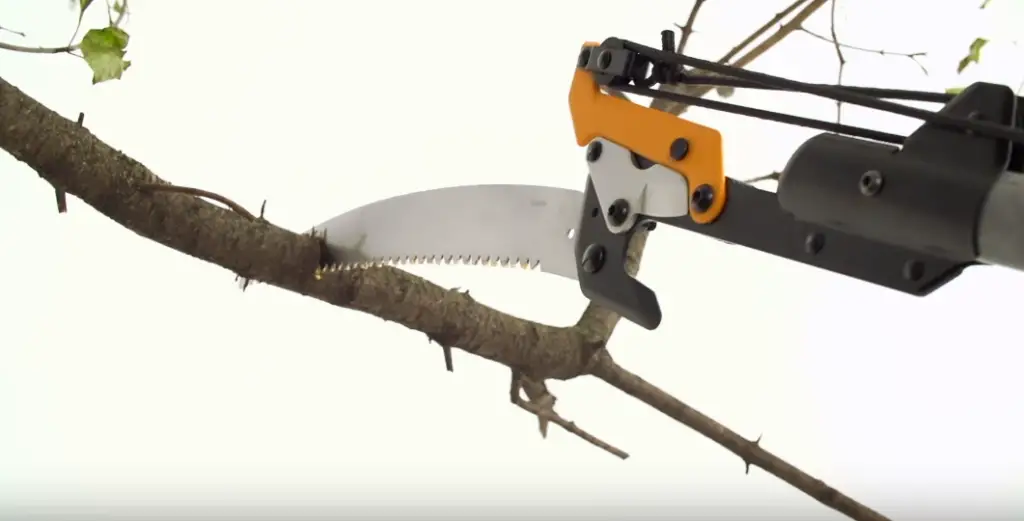Gardeners are constantly improving their toolbox and trying to facilitate daily work. One of these devices is a pole saw – a tree and bush cutter with a long handle. The main use of pole saws is to cultivate and prune trees/shrubs at high altitude. Mechanical, electric and gas-powered tools allow trimming the garden from the ground at a considerable height, which was previously a problem for many gardeners.

Basically, a pole saw is an advanced garden shear with a longer handle and a power-driven mechanism. These instruments are large enough, although certain models are quite portable and lightweight. Their distinctive feature is the length of the handle, which allows cutting branches without a significant physical effort.
The performance of the tool directly depends on the power of the installed engine. All pole saws have common features:
- mechanical or manual starting mechanism;
- collapsible, integral or telescopic rod that allows you to perform trimming at the comfortable height;
- power of some models makes it possible to trim even thick branches;
- anti-vibration system is installed on the devices;
- sophisticated design;
In addition, each model has individual features that distinguish it from competitors.
Table of Contents
Using a pole saw: the design matters
The use of a pole saw strictly depends on the device’s design. The design of the device is quite simple. A pole saw is a cutting part connected to the engine and equipped with a telescopic handle. Typically, the battery in these models is located at the bottom of the handle, where you have to hold on to your hand. Some tools have a rope for a hand, for additional comfort if the grip is not convenient enough.

Due to design features, all pole saws are divided into mechanical/manual or electrical, gasoline and battery-powered tools. Each of these types has its advantages and disadvantages, has distinctive design features. At its core, this is just like a small pruner for trimming tall trees.
Things to do before using a pole saw
- Check the tightness of all screws and bolts;
- Check the trigger lock before turning on the tool – it should move without any fails;
- The chain must be free from any damage signs;
- Check the fuel tank’s leaks (if you use a gas-based instrument);
- Check the air filter;
- Every month you need to replace a spark plug;
After every use of pole saw
- Do a thorough cleaning on the unit’s outside (just use a damp rag after a complete turn off the power);
- Don’t forget to clean the instrument below the protective cover around the saw’s blade;
- Keep the tool in a special bag;
- All connections and cables must be checked;
Peculiarities of using a manual pole saw
Manual pole saws are more effective at trimming and can be a good substitute for using a regular pruner, but they are less effective at trimming and brushing thick branches.
You will need to plan for each section that requires trimming. This includes where to cut (best a few inches from the main trunk if you are not cutting off a tree) and find out where and how the branch will fall.

Everything that may cause risk should be removed from the branch before the cutting begins. You might want to cut where the branch goes in a horizontal way, since the angled cuts are much more complicated.
Before you make a cut, make sure the branch is not too heavy. A heavy branch may split during the cutting process, damaging the tree.
Instead, you should trim the branch closer to the tip and move back to the main point of the cut, until the branch is light enough for a safe cut.
Create a recess in the branch so that you have a channel to cut through. This helps not only prevent damage to the tree from slipping, but also allows maintaining a better balance.
Saw slowly from top to bottom, using long, measured strokes. Remember that only one side is supported, so moving too fast can lead to separation. If the branch size is 1.5 inches or less, you can simply cut it off with a pruner.
Peculiarities of using an automatic pole saw
Using an automatic saw (gas or electric one) means much coarser cutting, similar to the one you would get with a chainsaw.

Brushing off is just a matter of turning on and gently launching the saw in front of you. In some very large areas, you can find saws that are used when connecting to a tractor or skid steer loader.
Dead branches are more prone to cracking and breaking, resulting in a dead limb falling off and leaving a rough stump. Cutting with an electric pole saw is quick and provides a less coarse cut than with a natural fall of a branch.
The purpose of a pole saw is to eliminate the need for stools and ladders. Some manufacturers offer the extension cords to help with branches out of reach. But sometimes you can’t do without a rope.
Tips on how to use a pole saw with a rope
If you really want to be safe while using a pole saw 10 feet above your head, there are a few tips to keep in mind:
- Make sure you avoid using plugged to the power equipment when it’s wet;
- Outside keep the instrument’s cord untangled;
- Watch out for electrical wires hitting your roof or roofs of your neighbors;
- Only cut one branch at a time and when you’re cutting a branch under tension watch out for the spring back when the branch is loose and snaps back or down right at you any branches;
- If you come across thicker than 8 inches, then just leave them be;
- Make sure that the rope doesn’t slip out;
- Always watch out for kickback and be careful during every minute of using a pole saw;
Expert recommendations when using any pole saw
- Correctly estimate the range of work. The number of trees plays a big role, the density of branches also plays a big role. Trimming a Christmas tree and pruning a fruit tree is a huge difference. Some branches grow very densely;
- Correctly estimate the tool’s range. Electric instruments are always limited by the source of electricity and the cord’s length. If we are talking about a small area, even with a dozen trees, then an electric instrument is quite enough. If you have a huge garden, then you need a gas-powered tool. For large trees, an electric model is better for the simple reason that pruning branches is better with a light tool rather than a heavy one. Gas models by default cannot be lightweight, and you need to hold them with two hands, not one;
- Correctly evaluate power. Thick branches are best cut with a more powerful technique than a weak one. After all, a weak engine can’t cope with branches that have grown and go to the backyards of your neighbors. A thickness of 10 cm may not be enough;
- Mind the noise level. The louder the tool is working, the faster it tires the nervous system, the higher it allows you to cut, the faster your eyes get tired, because you need to constantly peer into the distance, and you are not used to it. So, 2 factors are responsible for your convenience: the noise level and the handle’s length;
- Always use additional support like a rope and ladder;
- Try to keep the vertical instrument upright: your body weight is important for balance. It is difficult for a person of small weight to work with a tool of this length;
Comparison of Pole Saw Types
Pole saws are useful tools for trimming trees and branches that are hard to reach with a regular saw. This table compares the main features of different types of pole saws to help you choose the best one for your needs.
| Feature | Electric Pole Saw | Gas Pole Saw | Cordless Pole Saw |
|---|---|---|---|
| Power Source | Electricity | Gasoline | Battery |
| Weight | 8-15 lbs | 10-20 lbs | 7-12 lbs |
| Bar Length | 8-12 inches | 10-12 inches | 6-10 inches |
| Cutting Capacity | 6-10 inches | 10-12 inches | 6-8 inches |
| Noise Level | Low | High | Low-Medium |
| Price Range | $70-$200 | $150-$500 | $100-$300 |
This table compares the main features of electric, gas, and cordless pole saws, including their power source, weight, bar length, cutting capacity, noise level, and price range. Electric pole saws are the lightest and quietest, but they have a limited cutting capacity. Gas pole saws are the most powerful and can handle thicker branches, but they are heavier and noisier. Cordless pole saws are a good compromise between power and portability, but they may require frequent battery recharging. Choose the pole saw that best fits your needs and budget.
FAQ
How Do I Choose the Right Pole Saw?
When choosing a pole saw, consider the type of work you will be doing, the height of the branches you need to reach, and your physical strength. Manual pole saws are best for light pruning work, while electric and gas-powered pole saws are better suited for heavy-duty pruning work.
How Do I Set Up a Pole Saw?
To set up a pole saw, first, make sure the pole is fully extended and locked in place. Then, attach the saw to the end of the pole and tighten the screws or clamps to secure it in place. Finally, adjust the angle of the saw blade to the branch you want to cut.
What Safety Precautions Should I Take When Using a Pole Saw?
When using a pole saw, it is important to wear safety gear, including eye protection, gloves, and a hard hat. Make sure to keep both feet on the ground and never use the pole saw while standing on a ladder. Before using the saw, inspect it for any damage or wear and tear, and always follow the manufacturer’s instructions.
How Do I Maintain My Pole Saw?
To maintain your pole saw, keep the blade clean and sharp, and oil the chain regularly. Check the tension of the chain before each use and tighten it if necessary. Store the pole saw in a dry, cool place when not in use, and inspect it periodically for any signs of damage or wear and tear.
Can I Use a Pole Saw to Cut Down a Tree?
No, a pole saw should not be used to cut down a tree. Pole saws are designed for pruning and trimming branches, not for cutting down entire trees. Attempting to cut down a tree with a pole saw is dangerous and could cause serious injury or property damage.
What is the Maximum Height a Pole Saw Can Reach?
The maximum height a pole saw can reach depends on the length of the pole. Most pole saws have poles that range from 6 to 12 feet in length, which allows users to reach branches that are between 10 and 15 feet high. Some models may have extension poles that allow for even greater reach.
How Do I Store My Pole Saw?
To store your pole saw, clean the blade and chain and oil the chain before putting it away. Store the pole saw in a dry, cool place, and keep it out of reach of children and pets. If possible, store the saw with the blade detached from the pole to prevent damage.
What Should I Do If My Pole Saw Blade Gets Stuck?
If your pole saw blade gets stuck, stop using the saw immediately. Do not try to force the blade through the branch, as this could cause damage to the saw or result in injury. Instead, remove the saw from the branch and inspect the blade for damage or wear. If the blade is damaged, replace it before using the saw again.
Can I Use a Pole Saw in Wet Conditions?
No, a pole saw should not be used in wet conditions. Moisture can make the saw blade slippery and difficult to control, increasing the risk of injury. Additionally, using electrical pole saws in wet conditions can be dangerous and could result in electrocution. Always wait for the branches and surrounding area to dry before using a pole saw.
Do I Need to Sharpen the Blade of My Pole Saw?
Yes, the blade of your pole saw will need to be sharpened periodically to maintain its cutting ability. You can sharpen the blade yourself using a chainsaw file or take it to a professional for sharpening. A dull blade can make it difficult to cut through branches, which can be both frustrating and dangerous.
How Do I Sharpen the Blade of My Pole Saw?
To sharpen the blade of your pole saw, first, secure the saw in a vice or clamp to hold it steady. Then, use a chainsaw file to sharpen each tooth on the blade, following the angle of the existing bevel. Work from the inside of each tooth to the outside, using a smooth, consistent motion. Once you have sharpened all the teeth on one side of the blade, turn the saw over and repeat the process on the other side.
What Are the Benefits of Using a Pole Saw?
Using a pole saw offers several benefits, including increased safety, convenience, and efficiency. With a pole saw, you can prune branches without having to climb a ladder or use other equipment, which reduces the risk of injury. Pole saws are also lightweight and easy to maneuver, making them ideal for trimming hard-to-reach branches quickly and efficiently.
What Are the Most Common Uses for a Pole Saw?
The most common uses for a pole saw include pruning trees and shrubs, trimming overgrown branches, and clearing dead wood. Pole saws are also useful for cutting back branches that are growing too close to power lines or other structures, as well as for shaping hedges and bushes.
Can I Use a Pole Saw on Any Type of Branch?
No, you should not use a pole saw on branches that are thicker than the saw is designed to handle. Doing so can damage the saw blade or cause it to become stuck, which can be dangerous. Always check the manufacturer’s recommendations for the maximum diameter of branches that the saw can handle before using it.
What Should I Do If My Pole Saw Chain Falls Off?
If your pole saw chain falls off, stop using the saw immediately. Do not try to continue using the saw without the chain in place, as this could cause damage to the saw or result in injury. Instead, reattach the chain according to the manufacturer’s instructions before using the saw again.
Do I Need to Wear Ear Protection When Using a Pole Saw?
Yes, it is recommended to wear ear protection when using a pole saw, especially if you will be using it for an extended period. The high-pitched noise produced by the saw can cause hearing damage over time, so wearing ear protection is an important safety precaution.
Final advice about using a pole saw
Even with 10-year experience of using a pole saw, you ought to save your power when removing the branches of tall trees – divide the whole work for a few days. On the first day remove the branches for the time period lasting no more than 15-20 minutes, during the week gradually bring this time to an hour and a half. Ideally, it is recommended to use a pole saw with a rope for 30–50 minutes, then take a 10–15 minute break for rest or other work in the usual position of the body: collect the cut branches, cut the lower branches with pruners.
Always stay safe and never get distracted when working with such instruments!







Leave a Reply